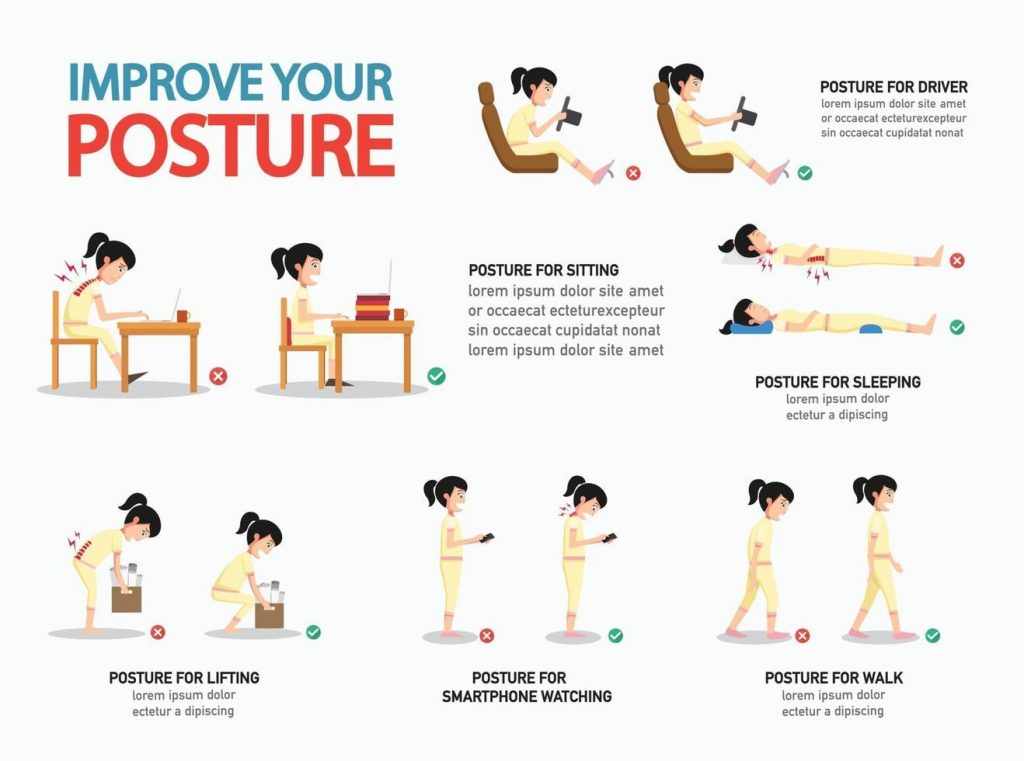Have you ever thought about the way you sit or stand? Is your spine straight? Do you tilt to one side? Do your shoulders slowly creep up closer to your ears as the day goes on? All of these may be adding up and ruining your posture.
Many people these days experience some kind of postural issue. They might deal with upper-crossed syndrome (forward head and rounded shoulders), lower-crossed syndrome (hips tilted backward and stomach protruding), or a combination of the two.
What makes matters worse, though, is the fact that a lot of these folks don’t even realize there’s anything wrong with the way they stand. Everyday habits that they don’t think twice about are affecting their posture and, in many cases, causing them to experience chronic back pain and neck pain.
If you have bad posture, with or without pain, it’s important to figure out whether or not any of your habits are contributing to it. Explained below are some of the most common bad habits that might be making your posture worse.

Bad Habits that Ruin Your Posture
Chances are you’re probably guilty of at least one of these bad habits. When repeated frequently, they can take a serious toll on your posture.
1. Looking Down at Your Phone
Staring down at your smartphone or tablet for hours on end puts a lot of pressure on your cervical spine (neck).
In fact, when your head is tilted down at a 60-degree angle, you place the equivalent of 60 pounds of added pressure on your neck. Doesn’t just thinking about that give you a headache?
Try holding your phone up at eye level to read text messages or articles instead of looking down at the screen.
2. Carrying a Heavy Bag
Whether it’s a laptop case, messenger bag, or a purse, carrying a heavy bag slung over one shoulder every day can seriously throw off your spinal alignment. Even wearing a heavy backpack can cause you to hunch forward to try and balance out the weight better.
Do what you can do lighten your load — get rid of extra books, or consider leaving your laptop at home.
Adjust your backpack straps, too, so that it sits higher on your back and is less likely to push you forward or pull you back.
3. Your Sleeping Position
How do you sleep at night? If you sleep on your stomach with your neck turned to one side, you’re probably setting yourself up for a lot of discomfort in the morning.
Sleeping on your stomach flattens out your spine, eliminating its natural curve, and places extra strain on your neck.
If you absolutely must sleep on your stomach, try putting a pillow below your pelvis and lower abdomen. This can bring back some of your spine’s natural curve back and minimize the stress placed on it at night.
4. Sitting at Your Desk Incorrectly
Finally, it’s essential to look at the way you sit at your desk. You spend eight-plus hours a day here during the work week; you ought to at least make sure you’re sitting in a way that minimizes damage.
Position your chair close your desk so you don’t have to lean forward to type. You also ought to adjust your chair so that you can keep your arms and wrists neutral (arms should be bent at 90-degree angles) while typing.
Raise your monitor so it’s at eye-level; that way, you don’t have to look down at the screen. Make sure your feet are flat on the floor, too, with your hips directly below your shoulders.
How to Improve Your Posture
In addition to swapping out these four bad habits for better ones, you can improve your posture in other ways as well. For example, you can try wearing a posture corrector for a few hours a day.
It’s also helpful to work on strengthening the muscles in your core (your abdominals, back muscles, and glutes) so that it’s easier to support yourself when you’re sitting and standing up straight.
It takes time to establish a new habit. But, if you put in the work and make an effort to practice regularly, you’ll find that your posture can improve fairly quickly.








